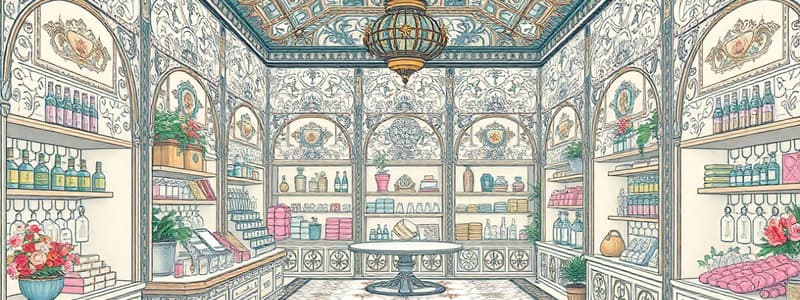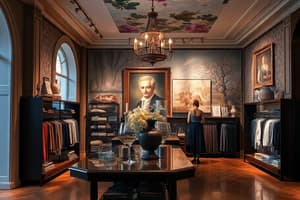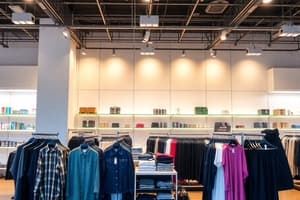Podcast
Questions and Answers
What is microretailing?
What is microretailing?
- A practice of customizing merchandise to meet local consumer needs. (correct)
- A strategy where retailers standardize merchandise in all locations.
- A method of increasing overall store size to boost sales.
- A form of online retailing that targets national markets.
Which of the following is NOT a type of space needed for store planning?
Which of the following is NOT a type of space needed for store planning?
- Online sales space (correct)
- Floor merchandise space
- Aisles and service areas
- Back room and offices
What does the space productivity index measure?
What does the space productivity index measure?
- The comparison between customer foot traffic and merchandise display area.
- The ratio of gross margin generated by a category to its selling space. (correct)
- The percentage of stock that is unsold at the end of the season.
- The ratio of a store's total sales to its operating expenses.
What is a planogram used for?
What is a planogram used for?
Which area is primarily focused on circulation in a store?
Which area is primarily focused on circulation in a store?
What is the purpose of allocating space in retail planning?
What is the purpose of allocating space in retail planning?
What do stack-outs refer to in a retail environment?
What do stack-outs refer to in a retail environment?
Which of these factors is important for shrinkage prevention?
Which of these factors is important for shrinkage prevention?
What is a key feature of shelving as a merchandising method?
What is a key feature of shelving as a merchandising method?
Which merchandising method involves using small rods to display items?
Which merchandising method involves using small rods to display items?
What does the term 'dumping' in merchandise presentation refer to?
What does the term 'dumping' in merchandise presentation refer to?
Which type of fixtures is commonly used for hanging apparel?
Which type of fixtures is commonly used for hanging apparel?
What is a disadvantage of pegging as a merchandising method?
What is a disadvantage of pegging as a merchandising method?
For which item type is shelving most commonly employed?
For which item type is shelving most commonly employed?
Which of the following is NOT a method of merchandise presentation mentioned?
Which of the following is NOT a method of merchandise presentation mentioned?
What is the primary benefit of using hanging as a presentation method?
What is the primary benefit of using hanging as a presentation method?
What is the primary goal of on-shelf merchandising?
What is the primary goal of on-shelf merchandising?
Which type of fixture is intended to hold a large amount of merchandise while maintaining an appealing appearance?
Which type of fixture is intended to hold a large amount of merchandise while maintaining an appealing appearance?
What characteristic distinguishes a feature fixture from other types of fixtures?
What characteristic distinguishes a feature fixture from other types of fixtures?
What is one requirement for effective merchandise presentation?
What is one requirement for effective merchandise presentation?
What is a common feature of hardlines fixtures?
What is a common feature of hardlines fixtures?
Which of the following best describes visual merchandising?
Which of the following best describes visual merchandising?
Which of the following is a characteristic of softlines fixtures?
Which of the following is a characteristic of softlines fixtures?
What is a key consideration when selecting fixtures for merchandise presentation?
What is a key consideration when selecting fixtures for merchandise presentation?
What merchandising method is best for creating a high fashion image?
What merchandising method is best for creating a high fashion image?
Which presentation method conveys a sense of high volume and low price?
Which presentation method conveys a sense of high volume and low price?
Which factor is NOT mentioned as a psychological consideration for merchandising?
Which factor is NOT mentioned as a psychological consideration for merchandising?
What is the primary use of vertical color blocking in merchandising?
What is the primary use of vertical color blocking in merchandising?
Where is stacking typically used for hardline merchandise?
Where is stacking typically used for hardline merchandise?
What merchandise type is primarily associated with the dumping method?
What merchandise type is primarily associated with the dumping method?
How can the method of stacking affect the perception of merchandise?
How can the method of stacking affect the perception of merchandise?
What is a disadvantage of using the dumping method?
What is a disadvantage of using the dumping method?
What is the primary characteristic of a retailer's name, logo, and retail identity?
What is the primary characteristic of a retailer's name, logo, and retail identity?
Which type of signage provides information about the store's merchandising mission and customer service policies?
Which type of signage provides information about the store's merchandising mission and customer service policies?
Where is category signage typically located in a retail environment?
Where is category signage typically located in a retail environment?
What is the main purpose of point-of-sale (POS) signage?
What is the main purpose of point-of-sale (POS) signage?
What is a key aspect of lifestyle graphics in visual merchandising?
What is a key aspect of lifestyle graphics in visual merchandising?
How are directional and departmental signage typically positioned within a store?
How are directional and departmental signage typically positioned within a store?
What is the common size characteristic of category signage compared to directional signage?
What is the common size characteristic of category signage compared to directional signage?
Which of the following best describes the role of lifestyle photography in retail?
Which of the following best describes the role of lifestyle photography in retail?
What is the primary guideline for selecting fixtures in a store?
What is the primary guideline for selecting fixtures in a store?
What is a key characteristic of visual merchandising?
What is a key characteristic of visual merchandising?
What is an essential aspect of storefront design?
What is an essential aspect of storefront design?
Why is lighting design significant in store design?
Why is lighting design significant in store design?
Which sensory aspect is involved in total sensory marketing?
Which sensory aspect is involved in total sensory marketing?
What is a consequence of poorly designed fixtures?
What is a consequence of poorly designed fixtures?
Which element is NOT typically considered in effective store design?
Which element is NOT typically considered in effective store design?
How should merchandise be presented according to proper fixture selection?
How should merchandise be presented according to proper fixture selection?
Flashcards
Microretailing
Microretailing
A chain store adapting its products and services to local needs within a specific trading area.
Stack-outs
Stack-outs
Pallets of merchandise displayed on the floor in front of shelves.
Space allocation
Space allocation
Planning how different areas of a store should be used.
Back room
Back room
Signup and view all the flashcards
Space productivity index
Space productivity index
Signup and view all the flashcards
Planograms
Planograms
Signup and view all the flashcards
Floor merchandise space
Floor merchandise space
Signup and view all the flashcards
Wall merchandise space
Wall merchandise space
Signup and view all the flashcards
On-shelf merchandising
On-shelf merchandising
Signup and view all the flashcards
Fixture types
Fixture types
Signup and view all the flashcards
Bulk/Capacity fixture
Bulk/Capacity fixture
Signup and view all the flashcards
Feature fixture
Feature fixture
Signup and view all the flashcards
Hardlines fixtures
Hardlines fixtures
Signup and view all the flashcards
Softlines fixtures
Softlines fixtures
Signup and view all the flashcards
Merchandise-presentation planning
Merchandise-presentation planning
Signup and view all the flashcards
Visual merchandising
Visual merchandising
Signup and view all the flashcards
Merchandise Presentation
Merchandise Presentation
Signup and view all the flashcards
Shelving
Shelving
Signup and view all the flashcards
Hanging
Hanging
Signup and view all the flashcards
Pegging
Pegging
Signup and view all the flashcards
Folding
Folding
Signup and view all the flashcards
Stacking
Stacking
Signup and view all the flashcards
Dumping
Dumping
Signup and view all the flashcards
Folding Technique
Folding Technique
Signup and view all the flashcards
Stacking Technique
Stacking Technique
Signup and view all the flashcards
Dumping Technique
Dumping Technique
Signup and view all the flashcards
Value/Fashion Image
Value/Fashion Image
Signup and view all the flashcards
Angles and Sightlines
Angles and Sightlines
Signup and view all the flashcards
Vertical Color Blocking
Vertical Color Blocking
Signup and view all the flashcards
45-Degree Customer Sightline
45-Degree Customer Sightline
Signup and view all the flashcards
Fixture Selection
Fixture Selection
Signup and view all the flashcards
Storefront Design
Storefront Design
Signup and view all the flashcards
Interior Design
Interior Design
Signup and view all the flashcards
Lighting Design
Lighting Design
Signup and view all the flashcards
Sensory Marketing
Sensory Marketing
Signup and view all the flashcards
Sound & Smell in Retail
Sound & Smell in Retail
Signup and view all the flashcards
Total Sensory Marketing
Total Sensory Marketing
Signup and view all the flashcards
Retail Identity
Retail Identity
Signup and view all the flashcards
Institutional Signage
Institutional Signage
Signup and view all the flashcards
Directional Signage
Directional Signage
Signup and view all the flashcards
Departmental Signage
Departmental Signage
Signup and view all the flashcards
Category Signage
Category Signage
Signup and view all the flashcards
Point-of-Sale (POS) Signage
Point-of-Sale (POS) Signage
Signup and view all the flashcards
Lifestyle Graphics
Lifestyle Graphics
Signup and view all the flashcards
Importance of Lifestyle Photography
Importance of Lifestyle Photography
Signup and view all the flashcards
Study Notes
Learning Objectives
- List the elements of a store's environment and define its two primary objectives.
- Discuss the steps involved in planning the store.
- Describe how various fixtures, merchandise presentation methods, and techniques, and the psychology of merchandise presentation are used to increase sales floor productivity.
- Describe why store design is so important to a store's success.
- Explain the role of visual communications in a retail store.
Introduction to Store Layout Management
- Elements of the store environment: This includes visual communications (retail identity, graphics, point-of-sale signage), store planning (space allocation, layout, circulation), store image and productivity, store design (exterior design, ambience, lighting), and merchandising (fixture selection, merchandise presentation, visual merchandising).
- Objectives of the store environment: Developing a store image and increasing space productivity.
Exhibit 13.1 - Elements That Compose the Store Environment
- Visual communications (retail identity, graphics, POS signage)
- Store planning (space allocation, layout, circulation)
- Store image and productivity
- Store design (exterior design, ambience, lighting)
- Merchandising (fixture selection, merchandise presentation, visual merchandising)
Introduction to Store Layout Management (continued)
- Objectives of the store environment: Developing a store image and increasing space productivity.
Store Planning
- Floor plan: A schematic that shows where merchandise and customer service departments are located, how customers circulate through the store, and how much space is dedicated to each department.
- Microretailing: Occurs when a chain store retailer tailors its merchandise and services to the needs of the immediate trading area.
- Stack-outs: Pallets of merchandise are set out on the floor in front of main shelves.
- Allocating space: Types of space needed (back room, offices, service areas, aisles, floor merchandise space, wall merchandise space); space allocation planning, circulation, shrinkage prevention.
- Space allocation planning: Improving space productivity in existing stores using the space productivity index (a ratio comparing the percentage of store gross margin generated by a merchandise category to the percentage of store selling space used by that category), space allocations for a new store.
- Planograms: Schematic illustrating how and where a retailer's merchandise should be displayed to increase customer purchases.
- Circulation: Includes free-flow, grid, loop, and spine layouts.
- Free-flow layout: Fixtures and merchandise grouped into free-flowing patterns on the sales floor.
- Grid layout: Counters and fixtures arranged in long rows ("runs") at right angles.
- Loop layout: Major customer aisle starts at the entrance, loops through the store (often circular, square, or rectangular), then returns customers to the front.
- Spine layout: A single main aisle runs from the front to back of the store, with departments branching off to either side, possibly using free-flow or grid patterns.
Planning Fixtures and Merchandise Presentation
- On-shelf merchandising: Display of merchandise on counters, racks, shelves, and fixtures throughout the store. Merchandise presentation must be attractive, easy to understand and access, and reasonably easy to maintain.
- Fixture types: Hardlines (e.g., hardware), often expensive, softlines (e.g., clothing), bulk or capacity fixtures intended to display bulk without a heavy appearance, feature fixtures drawing attention to product aspects (color, shape, style), wall fixtures.
- Merchandise presentation planning: Different methods such as Shelving, Hanging, Pegging, Folding, Stacking, Dumping.
- Shelving: The majority of merchandise placed on shelves in gondolas or wall systems, which is flexible and easy to maintain.
- Hanging: Apparel hung on hangers from softlines fixtures (e.g., round racks, four-way racks, or bars installed on gondolas or wall systems.)
- Pegging: Small merchandise can be hung from peg Hooks inserted into gondolas or wall systems; offers a neat, orderly presentation, although labor intensive.
- Folding: Can be used for higher-margin softlines and large merchandise, which can be folded and stacked onto shelves or placed on tables to create a high-fashion image.
- Stacking: Large hardline merchandise can be stacked on shelves, base decks of gondolas, or platforms (flats) directly on the floor; this offers a high-volume, low-price image.
- Dumping: Large quantities of small merchandise are dumped in bins or baskets inserted into gondolas or wall systems, suitable for softlines (e.g., socks, washcloths) or hardlines (e.g., batteries, candy); creates a high-volume, low-cost image.
- Key psychological factors: Value/fashion image, angles and sightlines, vertical color blocking.
Store Design
- Storefront design: Must clearly identify store name and nature; includes exterior signage and storefront architecture.
- Interior design: Surface finishes (materials used) and architectural shapes.
- Lighting design: Lighting greatly enhances store sales; requires in-depth knowledge of electrical engineering and how light affects color and texture.
- Sounds and smells: Store design should appeal to all human senses for total sensory marketing.
Visual Communications
- Name, logo, and retail identity: Must be catchy, memorable, and reflective of the retailer's mission.
- Institutional signage: Describes merchandising mission, customer service policies, and other retailer messages.
- Directional, departmental, and category signage: Large for easy visibility; category signage is smaller, placed near the merchandise.
- Point-of-sale signage (POS): Relatively small signage placed near merchandise to clearly state prices.
- Lifestyle graphics: Lifestyle images often display merchandise in use or with related items to convey a buying image. Photography should be generally attractive, avoiding offense to any group.
Studying That Suits You
Use AI to generate personalized quizzes and flashcards to suit your learning preferences.




